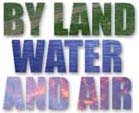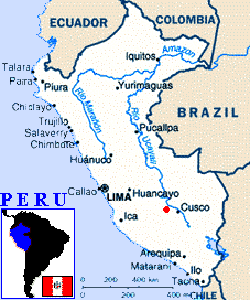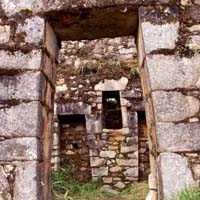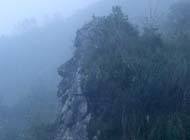
All Routes






| Duration: | 4+ days, 36 km roundtrip |
| Terrain: | Modern and Inca mountain roads |
| Scenery: | Inca ruins, snow covered mountains, Peruvian farmland |
| Highlight: | Inca Wasi, a well preserved, 2 story Inca ruin nestled in the Puncuyoc range |
| Transport to/from hike: | Bus or truck |
| Potable water: | Can be difficult to come by |
| Food on route: | Small shops only on the first section |
| Guides and horses: | ~US$7 p/day per guide & horse |
| Permits: | None required |
| Accommodation: | Tent |
| Expenses: | Accomodation, food, buses |
| Special Equipment: | Machete and our standard gear (hiking gear, medical kit). |
| Annoyances: | None |
The hike is possible in 3 days as a minimum, the first day being an 8 hour hike (that's 8 hours of actual walking, add time on for food and rest stops) to the Inca Wasi / Puncuyoc base camp, the second looking at the site and the third returning to Huancacalle. More reasonable is four days, giving one and a half days at the site having camped on the way up to Abra Huarina.
From Huancacalle to Yupanca follows the road down the Rio Vilcabamba valley, passing through smalls towns with views of farmholdings and mountains. The river rushes through this valley and has carved many of the rocks in its path into interesting shapes, it is easy to see why they were sacred to the Incas. Yupanca up to Abra Huarina starts as a steeply switch backed gravel path, crossing it is another, wider path of grass, this winds more slowly for the first section of climbing. After the switchbacks and forest patches, the path crosses many steep and soggy cow fields before opening to short shrubs and grasses to give views across the valley towards Inca Wasi. The path remains steep and clear until reaching Abra Huarina. After the turn off to traverse towards Puncuyoc the route starts to descend, the path being a mixture of muddy track and boggy field - there are also two extremely brief sections of Inca road. The descent to the base camp follows a route rather than a path for most of its length. After a section of muddy path following the base camp the path becomes a well defined Inca road, climbing around the sides of the hill and over a pass into Inca Wasi's valley. In the valley itself, the paths are very steep but well defined and paved.
As the cloud rolls in and out continually changing views of the mountains and the Puncuyoc range are visible; there are many shapes to see in the rocks. The flora changes from farmland to cloud forest patches, becoming more stunted as the path gains altitude. By the pass it has transformed in to tussock grass. In the Puncuyoc valley there are sections of cloud forest while most of the area is tussock grass and a kind of stunted bamboo. The snow topped mountains and glaciers of the Vilcabamba range that form the backdrop to the hike are spectacular.
The highlight is Inca Wasi, a very well preserved 2 story structure in a spectacular location. From the front patio, a giant pillar of rock from across the valley is reflected in a small pond that may have been created for this purpose. Clouds play a major role in the scenery of this site, blocking and creating various views as it swirls and clears from the valley. It is quite possible to be in cloud on one side of the building, unable to see anything beyond the outline nearest tree, while on the other side there are perfect views across the reflection pond.
Buses from Cuzco to Quillabamba and then on to Huancacalle. Services are frequent and reliable on the first leg, however, between Quillabamba and Huancacalle they run at eccentric times of day and can be cancelled if not enough passengers show up. Check with the locals for times on this leg of the journey. See Getting to Huancacalle on the information page
Water is pretty difficult to come by until reaching the base camp. Although the road follows the Rio Vilcabamba, the river is populated for much of its length and probably not good for drinking without high quality treatment. The first running water after leaving the valley is close to the pass at the top. The base camp contains a stream, we filtered and drank it without any problem. A further stream runs through the Puncuyoc site near the four way junction, again we filtered and drank this water without any problem. The thick layer of moss that grows on the tops of all of these mountains creates an odd phenomenon - while the area is almost constantly covered in cloud, and rain is very frequent, there are very few defined streams with flowing water. Instead the water slowly trickles under and through the moss, leading to the feeling of water being everywhere, and yet there is none to drink.
Sardines, pasta, bread, fizzy drinks and rice are all easily available in the small towns from Huancacalle to Yupanca, for anything else, it is best to bring it from Cuzco. There is little in the way of fresh fruit and vegetables in Vilcabamba, though these can be picked up in Quillabamba on the way to and from Cuzco. What food there is in the Rio Vilcabamba valley does not seem expensive, prices being comparable to the rest of southern Peru.
Anyone wishing to use guides and horses will have no problem securing them. Walking through any of the towns on the route from Huancacalle, and in Huancacalle itself, will produce plenty of friendly locals offering their services. For the best guides in the area, ask for one of the Cobos family at Sixpac Manco Hospedaje, however, don't be surprised if they have already been secured by another group. Expect to pay most guides around US$7 per day for each guide and horse.
Huancacalle has the Sixpac Manco Hospedaje run by the Cobos family offering riverside rooms and hot water showers. There are a further 2 hostels in town offering small, dark rooms with cold water showers. On the bus journey to Huancacalle from Cuzco, Quillabamba has a plethora of hostels of varying prices and qualities. To do this hike requires a tent/shelter.
We were lucky while there to not have to use our machete to see the site. However, this is not the normal situation, as Vincent Lee had hired the Cobos family to clear the site for his expedition studies during the month prior to our arrival. Others have spoken and written about excessive machete use to clear both the trails and the ruins upon arrival. The thick grasses of the cloud forests grow very quickly, and can completely cover the trails in only a few months, so it is best to be prepared.